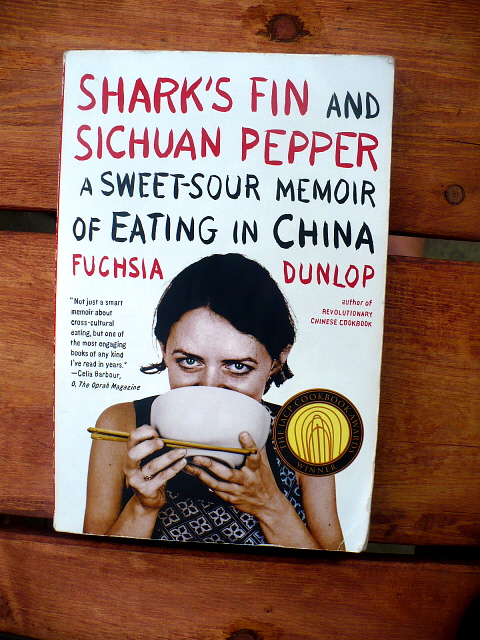Every
so often, and more often than it ought, the world handles surges of interest in fad diets.
From Atkins to grapefruit to paleo, GF, or whatever else, there always seems to be something new and kitschy to try in the search for
a foolproof weight loss technique. This one's got a good tagline with
a faint ring of truth. It's “Japanese Women Don't Get Old Or Fat”,
by Naomi Moriyama.
 This
is the tale of the author, her husband, and their joint desire to
share their experiences with Japanese home cooking. It made them feel
healthier, happier, and more energetic, as well as giving them
something to research- the reasons why it might have done so, and the
history behind its development.
This
is the tale of the author, her husband, and their joint desire to
share their experiences with Japanese home cooking. It made them feel
healthier, happier, and more energetic, as well as giving them
something to research- the reasons why it might have done so, and the
history behind its development.
Opening
with a wave of statistics about the Japanese lifestyle, the book
touts their long lifespan, low rates of obesity and heart disease,
low healthcare spending, and many other things. Always be suspicious
when statistics are used as primers, because you can use said
statistics to say virtually anything you want. 78% of statistics are
made up on the spot because they sound so effective!
Obligatory
attempt at Logos aside, the next pages turn to Pathos. First comes a
dramatic monologue in honor of the culinary skill, creativity, and
devotion of the author's mother. As any mother should, she gives all
for her children, even if they don't always appreciate it at the
time. After that comes a stern diatribe centering on how devoted the
Japanese are to freshness- foods not only dated, but *timed* at the
supermarkets, and even 7-11s stocking tasty, nutritious composed
bento instead of prefab salads and suspect sandwiches. Then came a detour
to detail the lifestyle of the glorious and rustic countryside, how
everything is so vibrantly flavored, fresh, and full of life!
It all felt so transparent, so obviously fabricated- but I couldn't put my
finger on why. Understanding came later.
While
the “How to Start Your Tokyo Kitchen” chapter is potentially
handy for the novice, the truth is that a good cook already knows
what equipment they need to cook dinner, and if they don't have it,
improvising isn't hard. Some of the later recipes call for
Japanese-exclusive cooking gear, and the author tells you how to
jury-rig one. Why not add those to the starting list of equipment in
the early chapter- perhaps as a closer? That's a much more suitable
time to detail where to get things a bit tougher to find.
Time
and pages aplenty are spent emphasizing the importance of at-table
garnishes and individual seasoning, in accordance with the Japanese
tendency not to individually plate, but rather allow self-service
from platters- a technique borrowed from China, just one of many.
It
grows quite tedious when a portion of every recipe's ingredient list
has 'to use at the table' as a caveat. Such a concept needs
explaining one time. After that's done, make a separate
section within the recipe for the garnishes and table condiments.
It's entirely too easy to confuse an inexperienced cook by piling all
the ingredients in one column without adequate direction. Considering
the prospective readership, I find this to be a massive, glaring
error.
A
full third of the book is devoted to what's termed “The Seven
Pillars of Japanese Home Cooking”. Fish, Vegetables, Rice, Soy,
Noodles, Tea, and Fruit are the vaunted pillars, and while each
subsection has several anecdotes and a handful of recipes, most of
them are rather banal. For a book that centers around what they term
'healthy eating', the number of recipes that use, say, refined sugar
as a fairly prominent ingredient is more than a little bothersome
when looked at with a more professional eye.
To
counteract that, there are stories aplenty that seek to emphasize the
healthy, life-giving qualities of the other ingredients. There's an
entire tale that centers around brown rice- the barest film of
historical reference is given to the fantastic tale of Tomoe Gozen,
then used to create a veneer of confidence in the nutritional
superiority of brown rice. I agree with the sentiment entirely, but
the method is shifty at best. Fiber isn't a miracle cure.
I
admit, I wanted to like this book, but I just can't bring myself to.
It's trying to be a cookbook and reference text, but it doesn't have
enough recipes to be reasonable as the former, or enough hard
nutrition facts to shore up the latter. Mostly it reads like a
slapdash memoir, bereft of the aura of legitimacy and believability
that often feels so necessary when creating a suitable referential
work. It's a collection of vignettes, loosely tied together around
the common theme of Japanese home cooking being healthy and happiness
inducing. Likewise, the book seems to hedge its bet, making the
premise sound like something a person has to try for themselves to
see if it works as advertised, rather than to try it and
expect results.
If
you're willing to trust the book and the author's message, feel free
to trust the recipes. Some of the 40-odd recipes sprinkled throughout
the book might serve you well, and there is a recipe index in the
back. I will not, however, offer any recommendations on which ones
are worth trying.
As
for me though, I'm not going to bother. This goes straight back to
the library- ideally in the fiction section where it belongs.
















